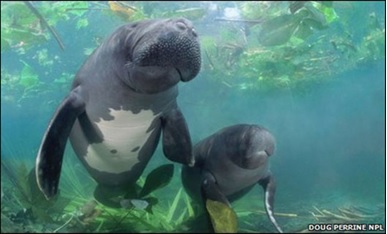Nuestras Investigaciones
2021
Dávila, C. (2021). Esfuerzos de conservación del manatí amazónico Trichechus inunguis (Natterer, 1833) en el Perú: una revisión actualizada. The Biologist (Lima), 19(2), 299-315. PDF
2019
Mendoza, P., Velasquez, J., Sanchez, J., Davila, L., Loja, D., Riveros, R., & Vilchez, C. (2019). Growth Curve of Amazonian Manatee (Trichechus inunguis) in Captivity. Aquatic Mammals, 45(4). PDF
2017
Espinoza, L. L., Mertins, O., Gama, G. S., Patta, A. C. F., & Mathews, P. D. (2017). A new Myxidium species (Myxozoa: Myxosporea) infecting the gallbladder of the turtle Podocnemis unifilis (Testudines: Podocnemididae) from Peruvian Amazon. Acta Tropica, 172, 75-79. PDF
Landeo-Yauri, S. S., Castelblanco-Martínez, N., & Williams, M. (2017). Behavior and habitat use of released rehabilitated Amazonian manatees in Peru. Latin American Journal of Aquatic Mammals, 12(1-2), 17-27. PDF
2017
Mendoza, P., Loja, D., Riveros, R., & Vilchez, C. (2017). Prediction equation of body weight of Amazonian manatee (Trichechus inunguis) calves in captivity using biometry. Natural Science, 9(5), 123-132. PDF
2016
Arévalo-Sandi, A. R., & CASTELBLANCO-MARTÍNEZ, D. N. (2016). INTERACTIONS BETWEEN CALVES OF AMAZONIAN MANATEES IN PERU: A STUDY CASE Interacciones entre crías de manatí amazónico en Perú: un caso de estudio. v. 21, n. 2. PDF
2015
Bolaños, K., & Erazo, N. V. C. (2015, December). Presencia de Cryptosporidium sp. en el Manatí Amazónico (Trichechus inunguis) en un Centro de Rescate en la Ciudad de Iquitos, Perú. In Memorias de la Conferencia Interna en Medicina y Aprovechamiento de Fauna Silvestre, Exótica y no Convencional (Vol. 11, No. 2, pp. 5-10). PDF
Arévalo-Sandi, A. R., & CASTELBLANCO-MARTÍNEZ, D. N. (2016). INTERACTIONS BETWEEN CALVES OF AMAZONIAN MANATEES IN PERU: A STUDY CASE Interacciones entre crías de manatí amazónico en Perú: un caso de estudio. v. 21, n. 2. PDF
2013
DELGADO, P., Perea, N. S., MATHEWS DELGADO, J. P., Garcia, C. B., Malheiros, A. F., & Garcia Davila, C. R. (2013). Detection of infection with Toxoplasma gondii in manatees (Trichechus inunguis) of the Peruvian Amazon. Acta Biológica Colombiana, 18(1), 211-216.
2012
Satizábal, P., Mignucci-Giannoni, A. A., Duchene, S., Caicedo-Herrera, D., Perea-Sicchar, C. M., García-Dávila, C. R., … & Caballero, S. J. (2012). Phylogeography and sex-biased dispersal across riverine manatee populations (Trichechus inunguis and Trichechus manatus) in South America. PLoS one, 7(12), e52468.
2011
Velásquez-Varela, L. J., Perea-Sicchar, C. M., Sánchez-Babilonia, J., Espinoza-Azan, M., Lee-Richardson, D., & Sigler, L. (2011). Manejo y rehabilitación del manatí amazónico (Trichechus inunguis) en cautiverio en el Perú. Ciencia Amazónica (Iquitos), 1(2), 104-113.
Behavior and habitat use of released rehabilitated Amazonian manatees in Peru
ABSTRACT
The Amazonian manatee (Trichechus inunguis) is endangered due to illegal hunting. In Peru, the Centro de Rescate Amazónico (CREA) rehabilitates and releases rescued manatees. Tree females and two males were released in El Dorado Lake in July 2011 and radio tracked until November 2011. Movements, habitat use and behavior recorded during the post-release period were used to evaluate the manatees’ adaptation to free-living conditions. A total of 140 locations was registered during 91 days of tracking. Females showed greater residence time than males, which migrated out of the lake. Females selectively used the micro habitats of the study area, preferring floating vegetation, followed by open water and lastly shore macrophytes. Most idling behaviors were registered in areas with floating macrophytes, and open water was mainly used for traveling. No correlation between sighting hour and sighting location (micro habitat type) was detected. The use of suitable zones, in addition to natural behavior, suggests that these rescued manatees responded well to free-living conditions after release. Some considerations are provided with the purpose of strengthening manatee rehabilitation programs and improving future releases, emphasizing the importance of choosing appropriate individuals, as well as suitable areas and times to help improve release outcome.
Keywords:
Habitat use, Post release monitoring, Radio telemetry, Trichechus inunguis, Amazonian manatee, Perú.
DOI: https://doi.org/10.5597/00234
Paper Link: Clic
Sarah Sofía Landeo-Yauri
Centro de Rescate Amazónico Carretera Iquitos-Nauta, km 13.8, Iquitos
Nataly Castelblanco-Martínez
Fundación Internacional para la Naturaleza y la Sostenibilidad (FINS A.C.) Calle Larún Manzana 75, lote 4, 75014 Andara, Chetumal, Quintana Roo
Martha Williams
Universidad Nacional Agraria La Molina Av. La Molina s/n, Lima

